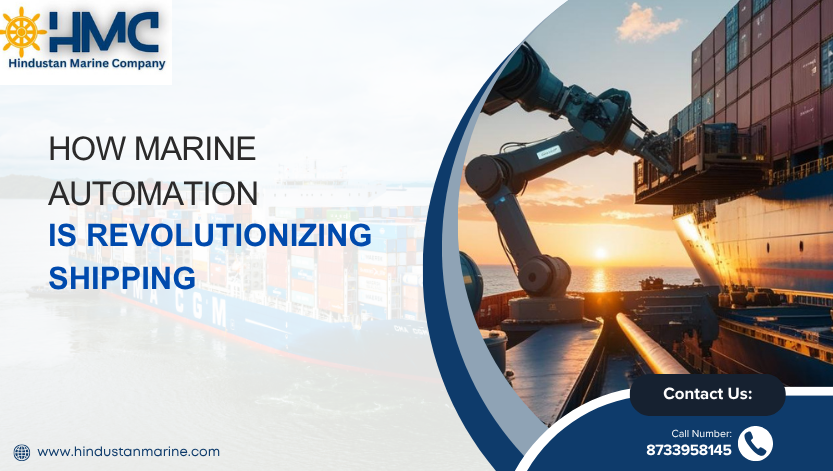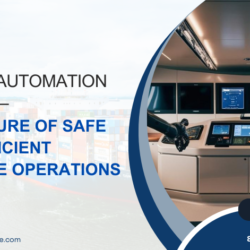
How Marine Automation is Revolutionizing Shipping
In the ever-evolving world of global trade, the shipping industry is undergoing a massive transformation, and at the heart of this change is marine automation. From ports like Mumbai and Mundra to shipping giants in Kochi and Chennai, India’s maritime sector is steadily moving towards smarter, more efficient operations. Thanks to advanced marine automation products, what once needed a full crew and manual monitoring can now be streamlined with the help of intelligent systems.
At Hindustan Marine CO., we believe automation isn’t just the future – it’s already changing the way the shipping industry works.
Understanding Marine Automation
Marine automation refers to the use of software, systems, and electronic tools that automate critical operations on ships. This includes navigation, engine monitoring, communication, safety alerts, and even cargo management.
Think of it like autopilot in aircraft – but for ships, with added intelligence and integration.
Current Adoption of Marine Automation in India
India has the second-largest coastline in Asia and handles over 95% of its trade volume by sea (as per Ministry of Ports, Shipping and Waterways). Naturally, the scope of automation is massive.
Major ports like:
- JNPT (Navi Mumbai)
- Mundra Port (Gujarat)
- Chennai Port (Tamil Nadu)
…have already started adopting automation to handle container tracking, berth scheduling, and cargo unloading through smart technologies.
Private shipping companies are also investing in marine automation products like real-time engine monitoring, GPS-based route optimization, and predictive maintenance tools.
Key Technologies Driving Marine Automation
Here’s a quick look at what’s powering this shipping revolution:
1. Internet of Things (IoT):
Sensors on ships collect and transmit data for real-time decision-making. From engine temperature to fuel levels, everything is monitored continuously.
2. AI & Machine Learning:
Systems learn from past voyages to optimize speed, fuel usage, and even avoid storms or traffic-heavy routes.
3. Autonomous Navigation:
Self-sailing vessels use radar, GPS, and AI to reduce human intervention. While India hasn’t reached fully autonomous ships yet, we’re making strides with semi-automated navigation systems.
4. Integrated Marine Management Software:
Platforms that combine multiple functions – like engine diagnostics, crew management, voyage planning – in one dashboard are becoming a must-have.
5. Digital Twins:
Creating a virtual replica of a ship to simulate and analyze performance before implementing changes on the actual vessel.
Benefits of Marine Automation in Shipping
The advantages are too many to ignore, especially for Indian shipping operators.
- Reduced Operating Costs:
Automated ships reduce crew requirements and maintenance costs. According to a report by Allied Market Research, autonomous shipping can cut operational costs by up to 20%. - Enhanced Safety:
Most maritime accidents are caused by human error. Automation reduces this risk by ensuring consistent monitoring and timely alerts. - Better Fuel Efficiency:
Smart route planning and engine monitoring improve fuel consumption. Even a 10% fuel saving can mean lakhs of rupees for cargo carriers. - Real-Time Insights:
Get updates on ship health, cargo conditions, and weather, all in one place. - Sustainability:
Optimized fuel usage leads to lower carbon emissions – helping India meet its IMO 2030 environmental goals.
Challenges in Adopting Automation in Indian Maritime Sector
While the benefits are promising, there are still some hurdles:
- Initial Investment:
Marine automation products require upfront costs. But with long-term ROI, many companies are beginning to see the value. - Skilled Workforce Shortage:
Operating and maintaining automation tools needs trained personnel. Indian maritime institutes are now slowly updating their curriculum. - Regulatory Delays:
Indian maritime laws are yet to catch up with full-scale automation. However, the Sagarmala Project and National Logistics Policy are positive steps in the right direction. - Cybersecurity Risks:
As ships become more digital, data protection becomes critical. Modern automation tools now include encrypted systems and threat detection.
Future of Marine Automation in India
India is set to become a key player in smart shipping.
By 2030, Indian ports aim to be 100% digitalized with IoT-enabled logistics systems. Projects like Port Community System (PCS 1x) are already connecting ports, shipping lines, and freight forwarders on a single digital platform.
Globally, autonomous ships are already being tested. Japan, Norway, and South Korea have launched pilot projects. India is not far behind. With our growing marine exports and supportive policies, we could be among the early adopters in the Asia-Pacific region.
Marine Automation and Sustainability
With global pressure to reduce carbon emissions, marine automation is a game-changer.
- Route optimization cuts down fuel waste
- Real-time engine monitoring detects inefficiencies early
- Smart load distribution reduces strain on machinery
These changes not only save money but also help in building a greener maritime industry. According to IMO, ships that adopt automation and smart systems can reduce CO₂ emissions by 30%.
Hindustan Marine CO. – Your Trusted Partner in Marine Automation
At Hindustan Marine CO., we offer the latest and most reliable marine automation products to help Indian shipping companies modernize operations, reduce costs, and enhance safety.
Whether you’re looking for:
- Smart navigation systems
- Real-time engine diagnostic tools
- Complete ship automation software
- Or even custom solutions for your fleet
…our team is ready to help you sail into the future of maritime logistics.
Conclusion
Marine automation is not just a global trend – it’s a necessity for Indian shipping companies that want to stay competitive in an increasingly digital world. With the right marine automation products, even small and mid-sized fleet operators in India can cut costs, improve safety, and ensure compliance with international shipping standards.
Now is the perfect time to automate and upgrade your marine operations. Ready to take the first step?





 Fast Delivery
Fast Delivery Easy Returns
Easy Returns Instant Quote
Instant Quote Product Demo
Product Demo
